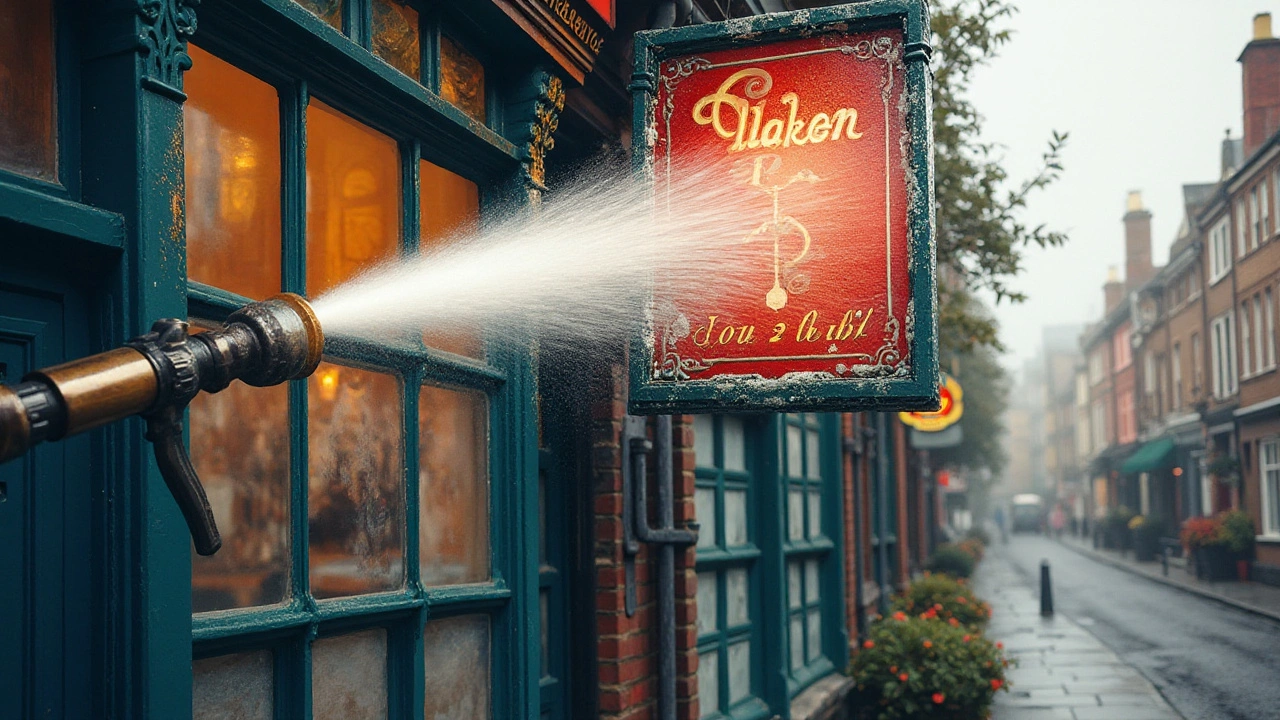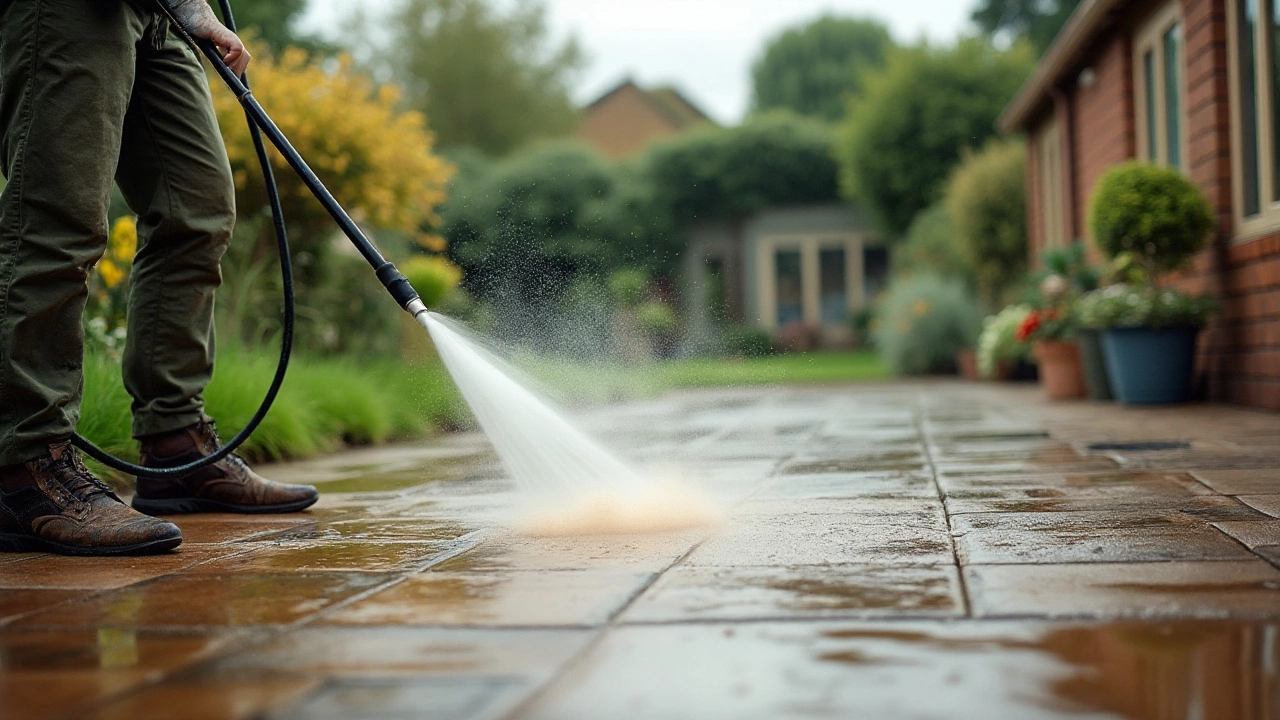Picture this: your driveway has seen better days, hosting a mural of tire marks and long-forgotten spills, an unsightly patchwork of grime. You could simply power wash it with water, but is that enough? Could soap be the secret weapon your pressure washer needs?
Diving into the soapy side of pressure washing isn't just about making bubbles. There's a crafty science behind when and why soap should be part of your cleaning arsenal. Let's explore how pairing soap with your pressure washer can turn that unyielding dirt into easy-to-wash-away grime, all while understanding its limits and possibilities. You're about to discover the hidden power of a sudsy sidekick and how it could make your cleaning routine not only more effective but also a tad bit more fun.
- The Science of Soap in Pressure Washing
- When Soap Makes Perfect Sense
- Choosing the Right Soap for Your Surface
- Environmental Considerations
- Mastering the Technique: Pressure Washing with Soap
The Science of Soap in Pressure Washing
When it comes to dirt removal, soap doesn’t just bring the excitement of foam and bubbles. It's actually a fascinating compound of chemistry. At the heart of this pressure washing miracle is the surfactant, an agent within the soap that modifies the surface tension of water. By doing so, the soap can penetrate and loosen the deep bonds dirt forms with surfaces, transforming stubborn grime into easy rinses.
The surfactant molecules are designed with two pivotal ends. One end is hydrophilic, which bonds well with water, and the other is hydrophobic, which clings to oils and dirt. When applied, these dual-natured molecules wedge themselves between the dirt and the surface, breaking the adhesive forces. This is why simply spraying water might not be enough; it’s like trying to wash away a greasy dish without dish soap. As one commercial cleaner phrased quite memorably, '
Soap is the diplomat your garden hose needs.'
Why Soap and Water Are Better Together
Using soap in your power washing achieves a deeper clean. It's like the bond that holds grime and surfaces together gradually unravels, making the pressure washing process significantly more efficient. Furthermore, soaps are adept at emulsifying oils, lifting them out so they can simply be rinsed away.
Much like washing your hands, soap helps tackle invisible bacteria and potential allergens on surfaces. The same reasoning applies to getting rid of mildew from patio stones or algae build-up on wooden decks. Without soap, your pressure washer might just give these clingy guests a temporary scare, but they’ll be back to party again in no time.
Choosing the Right Formula
Of course, the market offers a range of soaps explicitly formulated for different surfaces. As a rule of thumb, always go for specialty pressure washing soaps rather than household soaps, as the latter might cause harm or inadequately dissolve under high pressure. Check for pH-balanced labels and eco-friendly badges to safeguard both your surfaces and the environment.
Be cautious not to use any soap that will create excessive suds, as too much foam might clog up the mechanism or exert undue pressure on your washer. The golden rule: moderation in soap leads to gleaming exteriors without a hint of residue.
In wrapping up, incorporating soap in your pressure washing routine makes cleaning not only drastically more effective but fascinatingly scientific. The right soap can double the impact of the force being applied, changing how we view the seemingly simple act of washing to a deeper exploration of chemical interaction and manipulation.
| Soap Type | Best Use |
|---|---|
| Citrus-based | Removing grease and oil |
| Biodegradable | Environmentally conscious cleaning |
| Alkaline-based | Removing tough mineral stains |
When Soap Makes Perfect Sense
You might think it's common knowledge that soap helps remove dirt and grime, but what exactly makes it essential in certain pressure washing situations? The magic lies in how soap interacts with grease, oil, and organic matter—substances that water alone often struggles with.
Breaking Down the Barriers
Soap plays a crucial role in breaking down these stubborn materials by acting as a surfactant. Surfactants lower the surface tension of the water, making it better at spreading and penetrating dirt and oils. When combined with the force of a pressure washer, this means not just cleaning the surface, but stripping away layers of grime that might have remained otherwise. Think of it as a tag team: the soap loosens, and the high-pressure blasts it away.
Why Go for Soap?
- Greasy Surfaces: Oil spills on driveways or garage floors are prime candidates for soapy assistance. The surfactants effectively break down the oil, allowing you to wash it away effortlessly.
- Moss and Mildew: In corners where moisture lingers, mildew can thrive, making surfaces slippery and unsightly. Soap can penetrate these growths more effectively than water alone.
- Soot and Smoke Stains: For areas like chimneys or outdoor grills, where soot typically clings, soap aids in dissolving these stubborn particles.
Strategic Soap Selection
Not all soaps are created equal, and choosing the right one can make a world of difference. When cleaning delicate surfaces, you'll want to opt for a biodegradable, non-toxic soap to ensure you don't inadvertently cause damage or harm the environment. For tougher jobs, a degreasing soap might be more effective. Whatever the scenario, always read the labels to understand the intended use and compatibility with your pressure washer.
| Surface Type | Recommended Soap |
|---|---|
| Concrete/Driveways | Degreaser Soap |
| Wood Decking | Biodegradable Soap |
| Vehicles | Automotive Soap |
| Outdoor Furniture | Mild Detergent |
Simplicity and efficiency lie at the heart of why and when soap makes perfect sense in pressure washing. By understanding where, when, and how to use it, you can amplify your cleaning power and tackle even the most resilient grime with confidence.

Choosing the Right Soap for Your Surface
Not all soaps are created equal, especially when it comes to pressure washing. The soap you choose can make a significant difference in the quality of clean you achieve. Whether you're tackling a mossy patio, an oil-stained driveway, or a grimy vinyl siding, selecting the appropriate soap is crucial.
Types of Pressure Washing Soaps
First, let's break down the basic types of soaps available for pressure washing:
- All-Purpose Cleaners: These are versatile and can be used on a variety of surfaces. They're ideal for general dirt and grime but may lack the strength needed for tougher stains.
- Detergents: Often used for specific materials, detergents are engineered to remove more than just surface dirt. They're effective on oil and grease and are often used in automotive and heavy machinery cleaning.
- Biodegradable Options: If environmental impact is a concern, look for biodegradable soaps. These are formulated to break down rapidly without leaving harmful residues.
Matching Soap to Surface
It's paramount to match your soap to the surface you're cleaning. For instance, a detergent used for concrete may be too harsh for wood or other sensitive materials. Pressure washing experts recommend testing a small, inconspicuous area with your selected soap to ensure it doesn't cause any damage.
Common Surfaces and Recommended Soaps
| Surface | Recommended Soap Type |
|---|---|
| Vinyl Siding | All-Purpose or Mild Detergent |
| Concrete Driveways | Heavy-Duty Detergent |
| Wood Decks | Mild, Biodegradable Soap |
| Automobiles | Car Wash Soap (specific to automobiles) |
Remember, more foam doesn't necessarily mean better cleaning power. The effectiveness of the soap depends more on its chemical composition and the suitability for the surface being cleaned.
Tips for Using Soap Effectively
Incorporate these tips when using soap with your pressure washing routine:
- Follow Manufacturer Guidelines: Always stick to the instructions outlined by the soap manufacturer, particularly regarding dilution ratios.
- Use Appropriate Nozzles: Select a nozzle compatible with soap to ensure the dispersion is even and doesn't damage the surface.
- Rinse Thoroughly: Ensure all soap is rinsed away after cleaning. Residues can attract more dirt if left behind.
The right soap can elevate your pressure washing game. It's more than a mere accessory—it's an integral ingredient for achieving gleaming surfaces with minimal effort.
Environmental Considerations
When it comes to using soap in pressure washing, a conscientious approach to environmental impact is crucial. While the idea of soaping up your driveway might evoke images of spotless cleanliness, it's the aftermath—where those soapy suds flow—that requires thoughtful consideration. A well-intentioned cleaning session can potentially turn into an environmental hiccup if we're not careful about where those sudsy residues wind up.
Runoff and Waterways
The runoff generated by pressure washing can easily find its way into local storm drains, which often lead directly to rivers, lakes, or oceans without treatment. Most traditional soaps contain phosphates and surfactants that, when released into bodies of water, can upset natural ecosystems, promoting algae blooms that deplete oxygen and harm aquatic life. Therefore, selecting biodegradable soaps made specifically for pressure washing can mitigate much of these negative impacts.
Choosing Eco-Friendly Soaps
Fortunately, the demand for environmentally friendly cleaning products is on the rise, and the market offers an array of biodegradable soap options that are ideal for use with pressure washing equipment. These eco-friendly alternatives break down more readily in nature, lessening their impact on the environment.
Local Regulations and Best Practices
It's also wise to check your local regulations regarding pressure washing runoff. Some municipalities have specific guidelines or even restrictions concerning the use of soap to prevent environmental damage. In certain areas, you might be required to contain and properly dispose of all runoff to protect local water quality.
Practicing responsible pressure washing doesn’t stop at choosing the right soap. Consider washing surfaces during dry conditions to reduce runoff, and if possible, collect wastewater before it enters storm drains. Employing absorbent barriers around storm drain entry points while washing can also help in managing wastewater effectively.
Table: Biodegradable Soap Characteristics
| Feature | Description |
|---|---|
| Biodegradability | Breaks down naturally, reducing environmental harm |
| Phosphate-Free | Avoids contributing to algae blooms in waterways |
| Non-toxic | Safe for use around plants and wildlife |
| Plant-Based Ingredients | Made from renewable resources, minimizing fossil fuel use |
Incorporating these best practices into your pressure washing routine not only ensures a cleaner living environment but also protects the delicate balance of nature around us. As we strive for sparkling surfaces, let’s make sure our ecological footprints remain just as clean.

Mastering the Technique: Pressure Washing with Soap
So you've chosen to amplify your cleaning power by incorporating soap into your pressure washing routine. Great choice! The perfect symbiosis of soap and high-pressure water can tackle stubborn dirt with precision. However, the technique is key, ensuring that you draw out the best performance from your equipment without harming any surfaces.
Prepping Your Equipment and Surface
Before you start sudsing up, it's crucial to check your gear. Verify the compatibility of the soap with your particular pressure washer model. Some washers come with a specially designed detergent tank, while others require a downstream injector. Ensure that the soap is safely diluted as per manufacturer instructions to prevent any damage to your washer or the environment.
Moreover, always pre-soak the surface with plain water. This prepares the area by loosening dirt, allowing the soap to penetrate more effectively.
Applying Soap Correctly
When you're ready to start, apply the soap using a low-pressure nozzle; these are often colored black for easy identification. A lower pressure ensures the soap latches onto dirt rather than being blasted away.
- Start from the bottom up – this prevents streaks by allowing the soap solution to evenly cover the surface.
- Allow the soap to sit for 5-10 minutes without drying, giving it enough time to work its magic by breaking down the grime.
Rinsing Off the Soap
Switch to a high-pressure nozzle once the dwell time is complete. Essential here is a thorough rinse to clear away all the soap and embedded dirt, starting from the top down to wash it all away without leaving residues.
Keep a close eye on the rinse to ensure no soapy patches are left behind — these can attract new dirt quickly.
Pro Tip: Special Techniques for Different Surfaces
Different surfaces can react uniquely to washing with soap. For instance, using soap on wood might require special wood-friendly detergents to prevent wear or discoloration. Meanwhile, grease-caked driveways could benefit from a degreaser mixed with your soap solution for a more targeted attack.
Environmental Considerations
Lastly, always be mindful of the environmental impact. Choose biodegradable soaps that minimize ecological damage. After all, achieving a clean space shouldn't come at the expense of the planet.
| Surface Type | Recommended Soap |
|---|---|
| Concrete | Heavy-duty detergent |
| Wood | pH-neutral soap |
| Vehicles | Automotive-specific soap |
Incorporating soap into your pressure washing regime isn't just about extra power; it's about doing so wisely, ensuring DIY success that leaves surfaces immaculate and free from harm.
